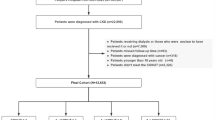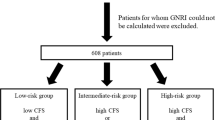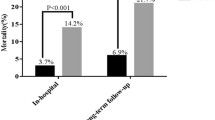Abstract
Glasgow prognostic score (GPS) has been used to evaluate inflammatory response and nutritional status. This study aimed to investigate the impact of nutritional status on cardiac prognosis by using GPS in patients after undergoing percutaneous coronary intervention (PCI). We included 862 patients who underwent PCI for stable angina pectoris between 2015 and 2018. We used the original cutoff values, which were an albumin (Alb) level of 3.5 g/dl and a C-reactive protein (CRP) level of 0.3 mg/dl. We categorized them into the three groups: originally defined GPS (od-GPS) 0 (high Alb and low CRP), 1 (low Alb or high CRP), and 2 (low Alb and high CRP). Major adverse clinical events (MACEs) included all-cause death, nonfatal myocardial infarction, revascularization, and hospitalization for heart failure. The median follow-up period was 398.5 days. During the follow-up, MACEs occurred in 136 patients. Od-GPS 2 had higher prevalence rates in terms of chronic kidney disease (CKD; 31.7% [229/722] vs. 44.9% [53/118] vs. 63.6% [14/22], p < 0.001), hemodialysis (6.4% [46/722] vs. 14.4% [17/118] vs. 31.8% [7/22], p < 0.001), and heart failure cases (HF; 9.1% [66/722] vs. 14.4% [17/118] vs. 27.3% [6/22], p = 0.007), with higher creatinine (1.17 ± 1.37 mg/dl vs. 1.89 ± 2.60 mg/dl vs. 3.49 ± 4.01 mg/dl, p < 0.001) and brain natriuretic peptide levels (104.1 ± 304.6 pg/ml vs. 242.4 ± 565.9 pg/ml vs. 668.1 ± 872.2 pg/ml, p < 0.001) and lower low-density lipoprotein cholesterol (101.5 ± 32.9 mg/dl vs. 98.2 ± 28.8 mg/dl vs. 77.1 ± 24.3 mg/dl, p = 0.002) than od-GPS 0 and 1.Od-GPS 2 (HR 2.42; 95% CI 1.16–5.02; p = 0.018), od-GPS 1 (HR 2.09; 95% CI 1.40–3.13; p < 0.001), diabetes (HR 1.41; 95% CI 1.00–1.99; p = 0.048), CKD (HR 2.10; 95% CI 1.49–2.96; p < 0.001), and HF (HR 1.64; 95% CI 1.05–2.56; p = 0.029) were independent predictors of MACEs. A scoring system using CRP and Alb levels with a milder definition than GPS suitably predicted the risk of MACEs in the patients who underwent PCI.




Similar content being viewed by others
References
Antonelli Incalzi R, Landi F, Cipriani L, Bruno E, Pagano F, Gemma A, Capparella O, Carbonin PU (1996) Nutritional assessment: a primary component of multidimensional geriatric assessment in the acute care setting. J Am Geriatr Soc 44:166–174
Landi F, Zuccala G, Gambassi G, Incalzi RA, Manigrasso L, Pagano F, Carbonin P, Bernabei R (1999) Body mass index and mortality among older people living in the community. J Am Geriatr Soc 47:1072–1076
Uchida S, Kamiya K, Hamazaki N, Matsuzawa R, Nozaki K, Ichikawa T, Suzuki Y, Nakamura T, Yamashita M, Kariya H, Maekawa E, Yamaoka-Tojo M, Matsunaga A, Ako J (2020) Association between sarcopenia and atherosclerosis in elderly patients with ischemic heart disease. Heart Vessels 35:769–775
Narumi T, Arimoto T, Funayama A, Kadowaki S, Otaki Y, Nishiyama S, Takahashi H, Shishido T, Miyashita T, Miyamoto T, Watanabe T, Kubota I (2013) Prognostic importance of objective nutritional indexes in patients with chronic heart failure. J Cardiol 62:307–313
Lane JS, Magno CP, Lane KT, Chan T, Hoyt DB, Greenfield S (2008) Nutrition impacts the prevalence of peripheral arterial disease in the United States. J Vasc Surg 48:897–904
Thompson D, Pepys MB, Wood SP (1999) The physiological structure of human C-reactive protein and its complex with phosphocholine. Structure 7:169–177
Pepys MB, Hirschfield GM (2003) C-reactive protein: a critical update. J Clin Investig 111:1805–1812
Forrest LM, McMillan DC, McArdle CS, Angerson WJ, Dunlop DJ (2003) Evaluation of cumulative prognostic scores based on the systemic inflammatory response in patients with inoperable non-small-cell lung cancer. Br J Cancer 89:1028–1030
Kaneko H, Yajima J, Oikawa Y, Tanaka S, Fukamachi D, Suzuki S, Sagara K, Otsuka T, Matsuno S, Funada R, Kano H, Uejima T, Koike A, Nagashima K, Kirigaya H, Sawada H, Aizawa T, Yamashita T (2013) Recent characteristics and outcomes of Japanese stable angina pectoris after percutaneous coronary intervention. An observational cohort study using the Shinken Database. Int Heart J 54:335–340
Numao Y, Suzuki S, Kano H, Yajima J, Oikawa Y, Matsuno S, Arita T, Yagi N, Semba H, Kato Y, Otsuka T, Uejima T, Yamashita T (2019) Eleven-year temporal trends of clinical characteristics and long-term outcomes in patients undergoing percutaneous coronary intervention for acute coronary syndrome in the Shinken database. Heart Vessels 34:199–207
Toiyama Y, Miki C, Inoue Y, Tanaka K, Mohri Y, Kusunoki M (2011) Evaluation of an inflammation-based prognostic score for the identification of patients requiring postoperative adjuvant chemotherapy for stage II colorectal cancer. Exp Ther Med 2:95–101
Bibek SB, Xie Y, Gao JJ, Wang Z, Wang JF, Geng DF (2015) Role of pre-procedural C-reactive protein level in the prediction of major adverse cardiac events in patients undergoing percutaneous coronary intervention: a meta-analysis of longitudinal studies. Inflammation 38:159–169
Matsumoto H, Kasai T, Sato A, Ishiwata S, Yatsu S, Shitara J, Murata A, Kato T, Suda S, Matsue Y, Hiki M, Takagi A, Daida H (2019) Association between C-reactive protein levels at hospital admission and long-term mortality in patients with acute decompensated heart failure. Heart Vessels 34:1961–1968
Libby P, Ridker PM, Maseri A (2002) Inflammation and atherosclerosis. Circulation 105:1135–1143
Patel S, Celermajer DS, Bao S (2008) Atherosclerosis-underlying inflammatory mechanisms and clinical implications. Int J Biochem Cell Biol 40:576–580
Salive ME, Cornoni-Huntley J, Phillips CL, Guralnik JM, Cohen HJ, Ostfeld AM, Wallace RB (1992) Serum albumin in older persons: relationship with age and health status. J Clin Epidemiol 45:213–221
Stenvinkel P, Heimburger O, Paultre F, Diczfalusy U, Wang T, Berglund L, Jogestrand T (1999) Strong association between malnutrition, inflammation, and atherosclerosis in chronic renal failure. Kidney Int 55:1899–1911
Kimmel PL, Phillips TM, Simmens SJ, Peterson RA, Weihs KL, Alleyne S, Cruz I, Yanovski JA, Veis JH (1998) Immunologic function and survival in hemodialysis patients. Kidney Int 54:236–244
Suzuki H, Asakawa A, Amitani H, Nakamura N, Inui A (2012) Cachexia and herbal medicine: perspective. Curr Pharm Des 18:4865–4888
Stenvinkel P, Heimburger O, Lindholm B, Kaysen GA, Bergstrom J (2000) Are there two types of malnutrition in chronic renal failure? Evidence for relationships between malnutrition, inflammation and atherosclerosis (MIA syndrome). Nephrol Dial Transplant 15:953–960
Yao Q, Lindholm B, Stenvinkel P (2004) Inflammation as a cause of malnutrition, atherosclerotic cardiovascular disease, and poor outcome in hemodialysis patients. Hemodial Int 8:118–129
Evans WJ, Morley JE, Argiles J, Bales C, Baracos V, Guttridge D, Jatoi A, Kalantar-Zadeh K, Lochs H, Mantovani G, Marks D, Mitch WE, Muscaritoli M, Najand A, Ponikowski P, Rossi Fanelli F, Schambelan M, Schols A, Schuster M, Thomas D, Wolfe R, Anker SD (2008) Cachexia: a new definition. Clin Nutr 27:793–799
Isenring EA, Capra S, Bauer JD (2004) Nutrition intervention is beneficial in oncology outpatients receiving radiotherapy to the gastrointestinal or head and neck area. Br J Cancer 91:447–452
May PE, Barber A, D’Olimpio JT, Hourihane A, Abumrad NN (2002) Reversal of cancer-related wasting using oral supplementation with a combination of beta-hydroxy-beta-methylbutyrate, arginine, and glutamine. Am J Surg 183:471–479
Bruera E, Strasser F, Palmer JL, Willey J, Calder K, Amyotte G, Baracos V (2003) Effect of fish oil on appetite and other symptoms in patients with advanced cancer and anorexia/cachexia: a double-blind, placebo-controlled study. J Clin Oncol 21:129–134
Esposito A, Criscitiello C, Gelao L, Pravettoni G, Locatelli M, Minchella I, Di Leo M, Liuzzi R, Milani A, Massaro M, Curigliano G (2015) Mechanisms of anorexia–cachexia syndrome and rational for treatment with selective ghrelin receptor agonist. Cancer Treat Rev 41:793–797
Ridker PM, Cushman M, Stampfer MJ, Tracy RP, Hennekens CH (1997) Inflammation, aspirin, and the risk of cardiovascular disease in apparently healthy men. N Engl J Med 336:973–979
Funding
This research received no grant from any funding agency in the public, commercial, or not-for-profit sectors.
Author information
Authors and Affiliations
Corresponding author
Ethics declarations
Conflict of interest
The authors declare no conflict of interest.
Additional information
Publisher's Note
Springer Nature remains neutral with regard to jurisdictional claims in published maps and institutional affiliations.
Rights and permissions
About this article
Cite this article
Noike, R., Amano, H., Suzuki, S. et al. Glasgow prognostic score can be a prognostic indicator after percutaneous coronary intervention: a two-center study in Japan. Heart Vessels 37, 903–910 (2022). https://doi.org/10.1007/s00380-021-01986-w
Received:
Accepted:
Published:
Issue Date:
DOI: https://doi.org/10.1007/s00380-021-01986-w




